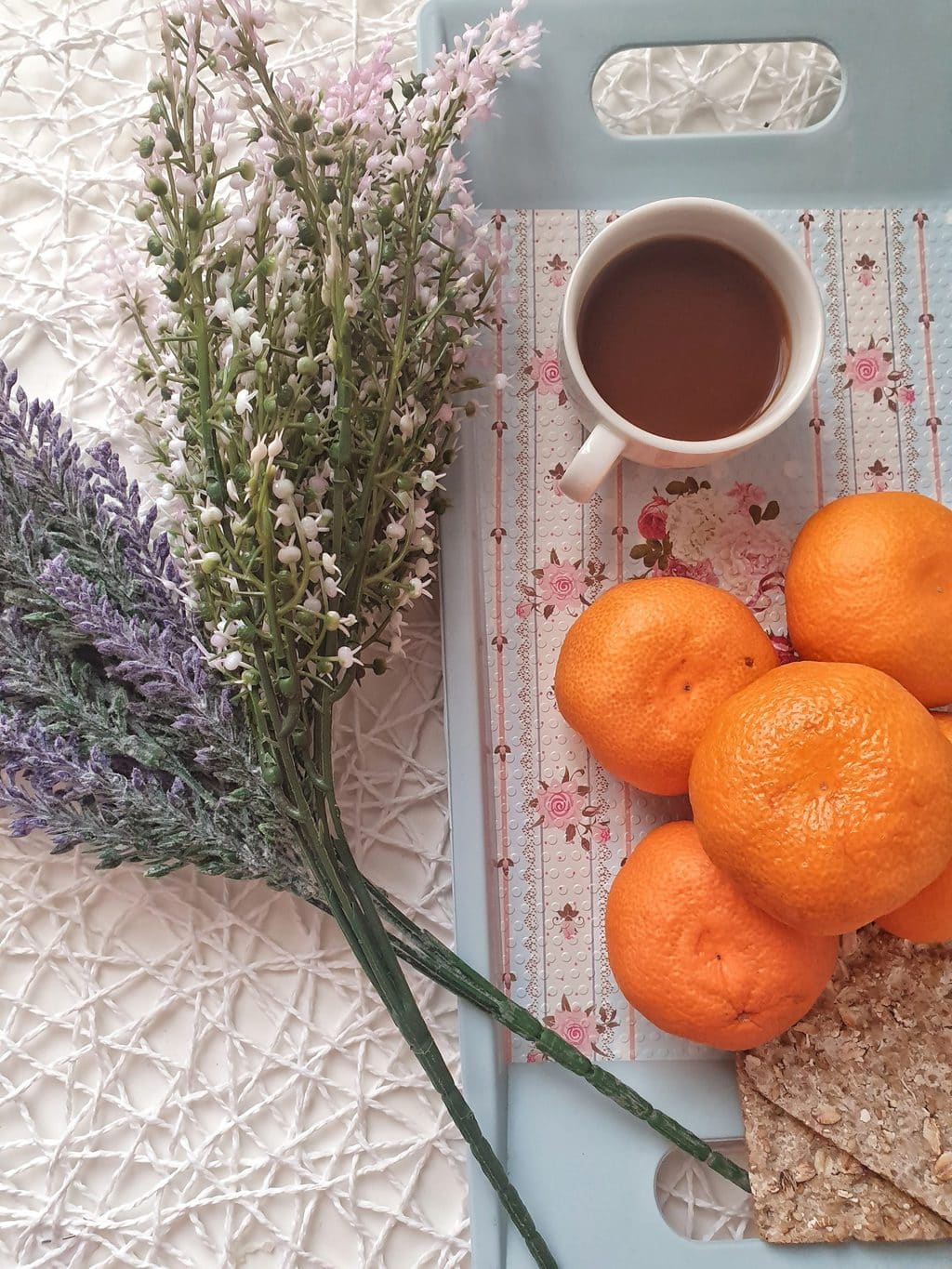Both longtime and new coffee drinkers have heard the term acidity used positively and negatively to describe a batch of coffee grounds. But not much is said to indicate what it means. That is, until now!

Read on for the full squeeze on your coffee cup’s level of acidity, from what it is to how to reduce it if needed.
Looking to know the other benefits and drawbacks of coffee? Find out here!
Acids vs. Bases
Chances are, your teacher covered acids and bases in your high school science class at least once. But we’re assuming it’s been a few years since your school days, and you’ve probably forgotten a thing or two. Let us walk you through a quick review. After all, understanding acids and bases is the first step of understanding the chemistry of coffee.
Acids are substances that measure below 7 on the pH scale. Bases, on the other hand, measure above 7 on the same scale. The former tend to have a rather sour taste, while the latter tend to make things like coffee taste bitter. When these substances are mixed, however, they neutralize each other.
How Acidic is Coffee?
All right, how does this information pertain to coffee experts like you, Roasty reader? Well, if you’ve decided joe is your daily drink of choice, it’s wise for you to have at least a little knowledge of the composition of roasted coffee. Black coffee is generally acidic, and though acidity levels vary depending on the type of brew, your cup of joe measures around 4 or 5 on the pH scale.
You should know about the acid content in coffee if you drink it regularly, but we don’t think your learning should stop there. We believe coffee lovers should also know how the drink’s acidity compares to other foods and beverages, which is why we gathered the information below.
Coffee vs. Tea
It’s not unusual for people to pit hot coffee versus tea, especially when they’re trying to decide which is better for warming you up on a chilly day. Acidity is often left out of the equation, but it’s far too important a factor to ignore!
Much like the acids in coffee, tea’s acidity varies pretty wildly depending on the type of leaves used. We mentioned earlier that the contents of your coffee pot fall somewhere around 5 pH, making it just as acidic as most black teas but more so than green teas, which tend to fall between 7 and 10 on the scale.
Other teas like chamomile or mint are also less acidic than a cup of fresh coffee; they’re almost neutral, coming in at 6 or 7 pH. Fruitier teas, on the other hand, are more acidic than joe. For example, if you’re sipping on rosehip, lemon, or blackberry tea, you’re looking at something between 2 and 3 pH.
Acid Content of Coffee vs. Other Substances
If you’re not much of a tea drinker, comparing the drink to other typical food and drink might give you a better idea of how acidic coffee beans can be.
The acidity of coffee is the same as bananas, measuring anywhere between 4.5 and 5.5 on the pH scale. Foods that are pretty close to neutral (remember, that’s 7 on the pH scale) include asparagus, broccoli, black olives, and spinach.
Frequent soda drinkers will find that their fizzy beverages are less acidic than pretty much any coffee brew, falling somewhere around 3 pH.
Acidity vs. “Brightness”
Still with us? Great! Now, let’s move on to one of the more complex elements of this discussion.
If you’re serious about your joe — and we know you are, since you’re on a website dedicated to coffee knowledge — you’ve probably seen the terms “brightness” or “bright acidity” printed on your bag of beans to describe their cupping notes. Usually, this makes acidity appear to be a desirable quality, posing a new question: why is the level of acidity in your coffee cup good sometimes but, in other instances, bad?
Sometimes, people aren’t using the term “acidity” to describe the coffee’s pH level; they’re referencing the joe’s flavor profile, and in those instances, bright acidity is seen as a good thing! These beans often have vibrant, intense flavors and usually taste fruity or citrusy.
And just for your information — to convince your friends you’ve got as much knowledge as the world’s most-famed coffee professionals — these brighter acidity beans usually hail from higher altitudes.
Is Acidity Bad for You?
Now, when you’re using the term “acidity” to refer to the flavor profile of a coffee bean, then no, it’s not bad for you. When you’re talking about its pH level, though, it’s a different story, and the “is it bad for you” question is rather complex.
There are as many as 30 different organic acids in your cup, and once you take a sip, the joe begins affecting the production of acids that are already inside of you. To help give you an idea of what a cup of delicious coffee can do to your body, let’s take a look at three major acids — two of them are found in your joe and the third in your stomach.
Chlorogenic Acid
First up is the naturally occurring chlorogenic acid. This functions as an antioxidant and contributes a good bit to perceived acidity. It breaks down during the coffee roasting process, so, as a result, light roast coffees tend to have a higher chlorogenic acid content than dark roasts. Because of its antioxidant properties, this acid is responsible for the rising popularity of light roasts.
Chlorogenic acid has been shown to help with weight loss by reducing glucose intake. However, the caffeine in coffee has been shown to have the same effect via different chemical reactions, so you don’t necessarily need high acidity coffee to achieve this.
Note: this type of acid is higher in robusta than arabica beans, which shows that having it in higher amounts doesn’t do much to improve the taste.
Quinic Acid
Remember how we mentioned chlorogenic acid breaks down as you roast coffee beans? Well, they have to break down into something, and that something is quinic acid.
Too much quinic acid causes that sour feeling in your stomach, so if you’re particularly sensitive to astringency, choose medium or lighter roasts.
Gastric Acid
Any time you take a few sips of your morning coffee, your body increases its production of stomach acid, a.k.a., gastric acid. But don’t worry; this is a normal reaction.
However, combine this acid with those found in your favorite drink, and you may experience a few issues. For example, if you’ve got gastrointestinal sensitivities, you may find this combination makes drinking coffee nearly impossible.
What About Decaf?
Decaffeinated coffee does not have significantly more or less acidity than a caffeinated coffee of the same origin. However, high caffeine can have some of the same side effects as high acid content. So, many people who are sensitive to acidity are likely sensitive to caffeine as well.
This is because caffeine encourages your stomach to generate more acid. So, if you have gastrointestinal issues that are irritated by acid, half-caff, or decaf coffees may be just as helpful as low acid coffee blends.
How to Reduce Acidity in Coffee

While Growing
While regular coffee may require extra steps during the roasting or brewing process, naturally-low acid joes don’t need that.
These beans’ low acid levels are usually a result of the soil composition, the altitude at which they are grown, and other environmental factors. So, to put it simply, when coffee brands or farmers are trying to produce a low acid product, location matters! Types of coffee from Brazil, Sumatra, Peru, Guatemala, and Mexico are good examples of this phenomenon.
Here’s something else acidity level conscious coffee drinkers should keep in mind: the coffee plant’s strain or varietal also affects the acidity levels in coffee. Generally, arabica beans are less acidic than their robusta counterparts, and because robusta beans are higher in caffeine, they cause your stomach to produce more acid as well.
While Roasting
Roasting green coffee beans extra slowly or intermittently can reduce the joe’s acidity. Steaming beans does the same thing, plus it gets rid of their waxy coat.
Dark roast coffee has lower chlorogenic acid levels and higher amounts of quinic acid, while light coffees are the opposite. This puts medium roasts right in the middle, with reasonably balanced acidity.
While Brewing
Cold Brew Coffee
One of the easiest ways to minimize the acidity of your coffee is to take heat entirely out of the equation. Cold-brewed coffee has a significantly lower acidity than hot coffees, typically measuring at around 6 on the pH scale. If you remember, hot brew coffees are somewhere between 4 and 5 on the scale.
A slow-steeped immersion method is better than a cold drip, but both coffee brewing methods are significantly better than just about any other process as far as acid content goes. Plus, it’s pretty easy to pull off if you’ve got a French press on hand.
Egg Coffee
Alkaline substances can neutralize acidic ones, and that’s precisely what happens when you introduce eggshells to your coffee brewing. This is an excellent solution if you still have an extra bit of time to invest in your brewing method but aren’t a fan of cold brewing coffee.
All you’ve got to do is put the eggshells in the filter with your coffee grounds and resume brewing your morning coffee as usual.
Salt
If adding eggshells doesn’t seem like your cup of tea (or coffee), some java experts recommend adding salt to your ground beans. Generally, this tip is for those who want to cut the bitter flavors from your brew, but it can also help neutralize coffee acidity and lower the chances of acid reflux.
The recommended salt-to-coffee ratio is a quarter teaspoon for every six tablespoons of joe. Don’t use much more than that, though, or you’ll taste the salt in your mug, which is just as bad as having overly acidic coffee.
Note: if you’ve got a sensitivity to increased sodium levels, a pinch of salt isn’t a good solution for you.
Frequently Asked Questions
What kind of coffee is the least acidic?
Now, we haven’t tried every bag of low acid coffee beans on the planet (yet), so we can’t exactly tell you which brew is the tamest in the acid department. We can, however, recommend our favorite low acid beans! Since we like to make sure we’ve got all of our bases covered at all times, we’ve already written an article about the best stomach-friendly coffee beans; you can check it out here.
Until you’ve got time to read it, however, keep the following recommendations in the back of your mind — and maybe go ahead and add them to your online shopping cart.
Lifeboost Coffee

Lifeboost Coffee
This organic Lifeboost Coffee is delicious, the cleanest, purest, and healthiest. It has no pesticides, chemicals, GMOs, or mycotoxins.
Our first recommendation comes from our friends at Lifeboost Coffee. This single-origin joe hails from the high altitudes of Nicaragua, and whether you choose one of the brand’s light, medium, or darker roasts, you — and your stomach — will appreciate the low acid content of the finished brew. We’ve got a full review of the brand you can check out here, but if you don’t feel like reading, here’s the short version: it’s some of the healthiest coffee you can buy!
Golden Ratio

Golden Ratio
This Golden Ratio coffee can be prepared like tea. Low acidity, no coffee breath, and easy preparation.
Next up is a batch of beans from Golden Ratio, and when we tell you this isn’t your average coffee beverage, we mean it. Golden Ratio beans are among the lightest roasted coffees on the market; they don’t even make it to the first crack. This means almost all of the original coffee flavor remains intact after being extracted with hot water. It goes down the gullet smoothly, hitting the spot every single time.
Puroast Coffee
Finally, we present to you Puroast Coffee. This dark roast type of coffee is marketed as perfect for every coffee drinker, especially those with gastroesophageal reflux disease, heartburn, or other acid-related sensitivities. These beans boast five times the antioxidants of products from other leading coffee brands, and they’re “pure to the pour,” which means no additives are ever involved in the production process. In short, Puroast is a pure roast indeed.
Does creamer neutralize the acid in coffee?
If you like hot or cold brew coffee with a splash of something extra, we’ve got great news: adding milk or creamer neutralizes coffee acidity! The calcium in these add-ins balances out the joe’s pH, therefore, making it less acidic.
Is instant coffee less acidic than brewed coffee?
While there are plenty of factors that determine the acid levels of your brew — the type of bean used, its roasting duration, your choice of coffee brewing methods — whether or not your coffee is instant isn’t one of them. Contrary to widespread rumors flying around the coffee world, instant coffee and regular coffee have the same acid levels.
The Last Sip
So, is coffee acidic?
Short answer: yes, and in more ways than one. Coffee is indeed acidic when it comes to both its spot on the pH scale and the flavors that’ll hit your palate.
Happy Caffeinating!








